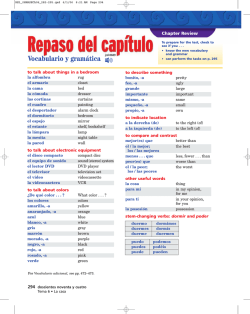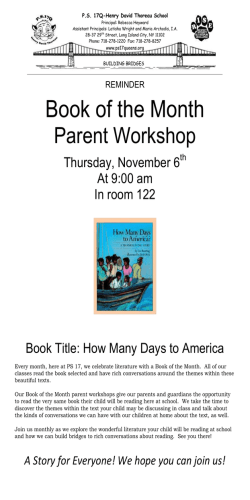
Little Red Riding Hood Activity Sheet in English and Spanish
Dear Parents, Please accept this book and suggested activities as a gift from Books for Kids for you and your child to enjoy together. Little Red Riding Hood is a classic fairy tale about a little girl, her grandmother, and a scary wolf. We hope sharing this great book will be a perfect way for you and your child to enjoy the experience of reading together. Books for Kids BEFORE READING TO INTRODUCE PRIOR KNOWLEDGE: Has your child read a fairy tale? They might be familiar with Cinderella,, The Three Billy Goats Gruff, or The Three Little Pigs. s. Ask them to tell you what they remember about the stories. Ask: Are these stories based on real life? What makes them different from real life? Your child might talk about the talking animals, animals doing things that people do, magic, or make believe. INTRODUCE STORY: Introduce the book to your child. Show them the front cover, read the title and point to the words. Introduce the author and illustrator. Ask your child to make a prediction about the book. You can ask: What do you think this story will be about? What do you see on the front cover that gives you clues about the book? What characters do you think we will read about? DISCUSS CONCEPTS: Little Red Riding Hood can be used to introduce young children how to be safe around strangers. After reading, ask your child: What is a stranger? What stranger did Little Red Riding Hood meet? What could she have done to be safe? What are some things you can do when you feel unsafe? Who are people that you can go to if you feel unsafe? READING Now read aloud for enjoyment. INVITATION TO PARTICIPATE: Read the story once through without interruption. Then, read it again, and talk about the illustrations. READ ALOUD TIPS FOR PARENTS • • • • • • • • • EXTEND THE STORY Ask your child to tell you about his or her favorite part of the book. Encourage them to tell you why. TURN OVER TO CONTINUE Read to your child every day. 15 minutes a day is all it takes. If you can’t, ask someone else to be your child’s designated reader. Try to find a quiet, comfortable place for reading together. Turn off other distractions, such as the radio or television. Read slowly enough so that your child has time to take in the story and look at the pictures. Follow the words with your finger so your child can see that words are read from left to right. Make reading engaging and interactive. Children may enjoy holding the book or turning the pages. Invite your child to read words and lines along with you. Read with expression. Try creating different voices for different characters. Don’t worry about reading perfectly, though. Encourage your children to ask questions about the characters, pictures, plot, and words. Talk about the story with your child. Ask open-ended uestions starting with “why,” “what,” and “how.” Your child may want you to read the same story over and over again. That’s great! After several retellings, ask your child to tell you the story. Most importantly – HAVE FUN! If you do, your child will too! Activity: Little Red Riding Hood carries a basket to her Grandmother’s house. Pretend that you are going on a trip. What would you pack in your basket? Draw a picture to illustrate the things you would carry in your basket. Name: Apreciados padres de familia: Por favor acepten este libro y las actividades sugeridas como un obsequio de Books for Kids para que lo disfruten junto con sus hijos. Caperucita Roja es un cuento de hadas clásico sobre una pequeña niña, su abuela y un lobo desalmado. Esperamos que compartir este gran libro sea la forma perfecta para que ustedes y sus hijos disfruten juntos la lectura. Books for Kids ANTES DE LEER PARA PRESENTAR EL CONOCIMIENTO PREVIO: ¿Su hijo ha leído un cuento de hadas? Pueden estar familiarizados con Cenicienta, Las tres cabras macho Gruff o Los Tres Cerditos. Pídales que le cuenten lo que recuerdan de esas historias. Pregunte: ¿Estas historias están basadas en la vida real? ¿Qué las diferencia de la vida real? Su hijo puede hablar sobre los animales que hablan, los animales que hacen cosas que hacen las personas, o imaginarios. PRESENTE LA HISTORIA: Presente la historia a su hijo. Muéstreles la cubierta, lea el título y señale las palabras. Presente al autor y al ilustrador. Pida a su hijo que haga una predicción sobre el libro. Puede preguntar: ¿Sobre qué crees que será la historia? ¿Qué puedes ver en la cubierta que te de pistas sobre el libro? ¿Sobre cuáles personajes crees que leeremos? DISCUTAN LOS CONCEPTOS: Caperucita Roja puede usarse para enseñar a los niños pequeños cómo estar seguros con personas extrañas. Después de leerlo, pregunte a su hijo: ¿Qué es un extraño? ¿Qué extraño encontró Caperucita Roja? ¿Qué pudo ella haber hecho para estar segura? ¿Cuáles son algunas cosas que puedes hacer cuando te sientes inseguro? ¿A quiénes puedes acudir cuando te sientes inseguro? LECTURA Ahora lee en voz alta por diversión. INVITACIÓN A PARTICIPAR: Lea la historia una vez más sin interrupciones. Luego, léala de nuevo y hablen sobre las ilustraciones. AMPLÍE LA HISTORIA Pida a su hijo que le hable sobre su parte favorita de la historia. Anímelos para que le digan por qué. PASE LA PÁGINA PARA CONTINUAR LEA EN VOZ ALTA CONSEJOS PARA LOS PADRES • • • • • • • • • Lea con su hijo todos los días. 15 minutos al día es todo lo que se necesita. Si usted no puede, designe a otra persona para con su hijo. Trate de encontrar un lugar tranquilo y cómodo para leer juntos. Apague otras distracciones, tales como la radio o la televisión. Lea lo suficientemente lento como para que su hijo tenga tiempo para disfrutar de la historia y mirar las figuras. Siga las palabras con el dedo para que su hijo pueda ver que las palabras se leen de izquierda a derecha. Haga que la lectura sea interactiva y atractiva. Los niños pueden disfrutar con el libro o pasar las páginas. Invite a su niño a leer palabras y líneas junto con usted. Lea con expresión. Trate de crear diferentes voces para diferentes personajes. No se preocupe de leer perfectamente la historia. Anime a sus niños a hacer preguntas sobre los personajes, la trama, las imágenes y las palabras. Hablar de la historia con su hijo. Hacer preguntas abiertas que comienzan con “porque”, “qué” y “cómo”. Su hijo puede querer leer la misma historia una y otra vez. Eso es genial! Después de varias narraciones, pídale a su niño que le cuente la historia. Lo más importante es DIVERTIRSE! Si lo hace, su hijo también lo hará! Actividad: Caperucita Roja lleva una canasta a la casa de su abuela. Pretenda que está saliendo de viaje. ¿Qué empacarías en la canasta? Haz un dibujo para ilustrar las cosas que llevarías en tu canasta. Nombre:
© Copyright 2025

